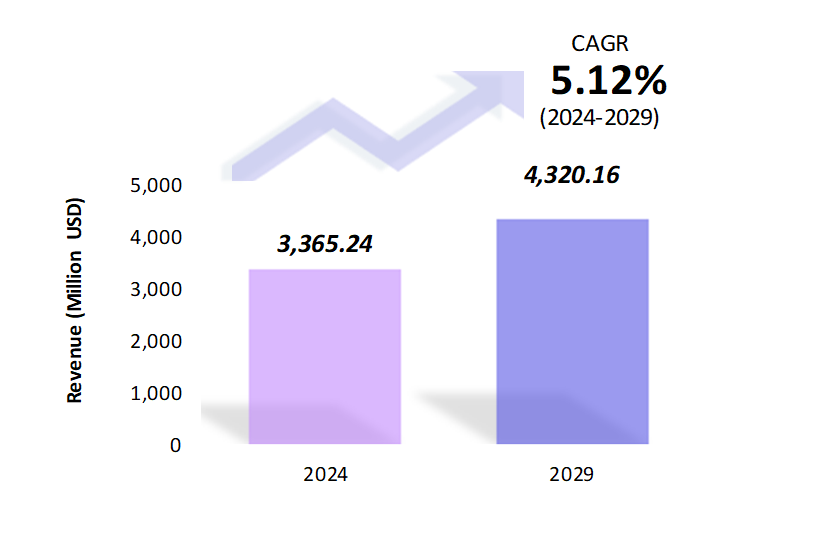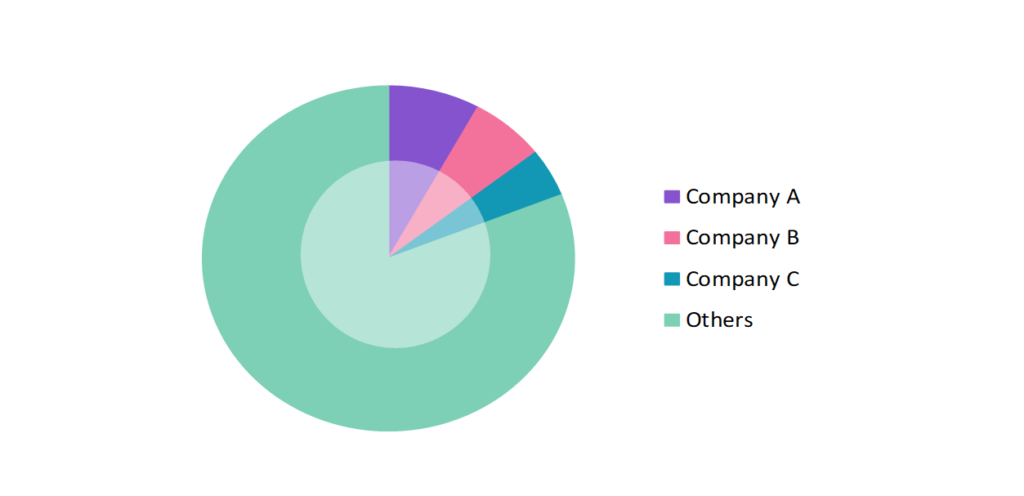Citral Market Analysis: Growth, Size, Share & Future Trends (2024-2029)
The market report provided a comprehensive analysis segmented by Application (Synthesis of Vitamin A & E, Lemon Essence, Menthol, Others); by Product Type (Natural, Synthetic); by End Use (Cosmetics & Personal Care, Household Care, Laundry Detergents & Cleaners, Dishwashers, Food & Beverages, Air Care, Others); by Geography (North America, South America, Asia Pacific, Europe, The Middle East, Africa).
Outlook

- The citral market is estimated to be at USD 3,365.24 Mn in 2024 and is anticipated to reach USD 4,320.16 Mn in 2029.
- The citral market is registering a CAGR of 5.12% during the forecast period of 2024-2029.
- The citral market is experiencing robust growth, driven by its widespread use in the flavor, fragrance, and pharmaceutical industries. With increasing consumer preference for natural and organic products, demand for citral sourced from natural ingredients is on the rise.
Request a free sample.
Ecosystem

- The participants in the global citral industry are always developing their strategies to preserve a competitive advantage.
- Companies in citral Market hold significant market shares due to their extensive production capabilities and established distribution networks. BASF has invested heavily in citral production facilities, ensuring a significant market share.
- Several important entities in the citral market include BASF Group; Zhejiang NHU Co., Ltd.; Takasago International Corp.; Jiangxi Global Natural Spice Co., Ltd.; Vigon International, Inc.; and others.
Ask for customization.
Findings
| Attributes | Values |
|---|---|
| Historical Period | 2018-2022 |
| Base Year | 2023 |
| Forecast Period | 2024-2029 |
| Market Size (2024) | USD 3,365.24 Mn |
| Market Size (2029) | USD 4,320.16 Mn |
| Growth Rate | 5.12% CAGR from 2024 to 2029 |
| Key Segments | Application (Synthesis of Vitamin A & E, Lemon Essence, Menthol, Others); Product Type (Natural, Synthetic); End Use (Cosmetics & Personal Care, Household Care, Laundry Detergents & Cleaners, Dishwashers, Food & Beverages, Air Care, Others); Geography (North America, South America, Asia Pacific, Europe, The Middle East, Africa) |
| Key Vendors | BASF Group; Zhejiang NHU Co., Ltd.; Takasago International Corp.; Jiangxi Global Natural Spice Co., Ltd.; Vigon International, Inc. |
| Key Countries | The U.S; Canada; Mexico; Brazil; Argentina; Colombia; Chile; China; India; Japan; South Korea; The UK; Germany; Italy; France; Spain; Turkey; UAE; Saudi Arabia; Egypt; South Africa |
| Largest Market | Asia Pacific |
Get a free quote.
Trends
- Natural Sourcing Preference: There’s a growing trend towards sourcing citral from natural ingredients like lemongrass and citrus fruits, reflecting a shift towards organic products. For instance, companies like Symrise are investing in the sustainable farming of lemongrass in Asia.
- Expansion in Flavor and Fragrance Industry: Citral’s application in creating lemony scents has seen increased adoption in perfumes and food flavorings. Brands like L’Oréal are incorporating citral-derived fragrances in their latest product lines.
- Rise in Pharmaceutical Applications: Emerging trends show citral being used for its antimicrobial properties in topical medications. Pharmaceutical companies are exploring its potential in new drug formulations.
Speak to analyst.
Catalysts
- Increasing Demand in Food and Beverage Sector: The flavoring properties of citral drive its use in beverages and confectioneries, boosting revenue. Coca-Cola, for example, utilizes citral in some of its citrus-flavored drinks.
- Growth in Personal Care Industry: The surge in demand for scented personal care products like shampoos and lotions propels citral sales. Brands such as Dove incorporate citral for its refreshing aroma.
- Advancements in Chemical Synthesis: Improved methods for synthesizing citral have reduced production costs, enhancing profitability. Firmenich has developed efficient synthesis techniques to meet market demands.
Inquire before buying.
Restraints
- Supply Chain Disruptions: Dependence on natural sources like lemongrass can lead to shortages due to climate issues, affecting supply. Recent floods in key growing regions have disrupted raw material availability.
- Regulatory Restrictions: Stricter regulations on allergenic compounds can limit citral usage in products, posing challenges. The EU’s cosmetic directive mandates the labeling of citral due to potential allergic reactions.
- Synthetic Alternatives Competition: The emergence of synthetic flavoring agents offers cheaper alternatives, potentially reducing citral’s market share. Some manufacturers are opting for synthetic lemon flavors over natural citral.
Personalize this research.
Hotspot

Explore purchase options.
Table of Contents
| 1. Introduction 1.1. Research Methodology 1.2. Scope of the Study 2. Market Overview / Executive Summary 2.1. Global Citral Market (2018 – 2022) 2.2. Global Citral Market (2023 – 2029) 3. Market Segmentation 3.1. Global Citral Market by Application 3.1.1. Synthesis of Vitamin A & E 3.1.2. Lemon Essence 3.1.3. Menthol 3.1.4. Others 3.2. Global Citral Market by Product Type 3.2.1. Natural 3.2.2. Synthetic 3.3. Global Citral Market by End Use 3.3.1. Cosmetics & Personal Care 3.3.2. Household Care 3.3.3. Laundry Detergents & Cleaners 3.3.4. Dishwashers 3.3.5. Food & Beverages 3.3.6. Air Care 3.3.7. Others 4. Regional Segmentation 4.1. North America 4.1.1. The US 4.1.2. Canada 4.1.3. Mexico 4.2. South America 4.2.1. Brazil 4.2.2. Argentina 4.2.3. Colombia 4.2.4. Chile 4.2.5. Rest of South America 4.3. Asia Pacific 4.3.1. China 4.3.2. India 4.3.3. Japan 4.3.4. South Korea 4.3.5. Rest of Asia Pacific 4.4. Europe 4.4.1. The UK 4.4.2. Germany 4.4.3. Italy 4.4.4. France 4.4.5. Spain 4.4.6. Rest of Europe 4.5. The Middle East 4.5.1. Turkey 4.5.2. UAE 4.5.3. Saudi Arabia 4.5.4. Rest of the Middle East 4.6. Africa 4.6.1. Egypt 4.6.2. South Africa 4.6.3. Rest of Africa 5. Value Chain Analysis of the Global Citral Market 6. Porter Five Forces Analysis 6.1. Threats of New Entrants 6.2. Threats of Substitutes 6.3. Bargaining Power of Buyers 6.4. Bargaining Power of Suppliers 6.5. Competition in the Industry 7. Trends, Drivers and Challenges Analysis 7.1. Market Trends 7.1.1. Market Trend 1 7.1.2. Market Trend 2 7.1.3. Market Trend 3 7.2. Market Drivers 7.2.1. Market Driver 1 7.2.2. Market Driver 2 7.2.3. Market Driver 3 7.3. Market Challenges 7.3.1. Market Challenge 1 7.3.2. Market Challenge 2 7.3.3. Market Challenge 3 8. Opportunities Analysis 8.1. Market Opportunity 1 8.2. Market Opportunity 2 8.3. Market Opportunity 3 9. Competitive Landscape 9.1. BASF Group 9.2. Zhejiang NHU Co., Ltd. 9.3. Takasago International Corp. 9.4. Jiangxi Global Natural Spice Co., Ltd. 9.5. Vigon International, Inc. 9.6. Company 6 9.7. Company 7 9.8. Company 8 9.9. Company 9 9.10. Company 10 |
Know the research methodology.
Citral Market – FAQs
1. What is the current size of the citral market?
Ans. In 2024, the citral market size is $3,365.24 Mn.
2. Who are the major vendors in the citral market?
Ans. The major vendors in the citral market are BASF Group; Zhejiang NHU Co., Ltd.; Takasago International Corp.; Jiangxi Global Natural Spice Co., Ltd.; Vigon International, Inc.
3. Which segments are covered under the citral market segments analysis?
Ans. The citral market report offers in-depth insights into Application, Product Type, End Use, and Geography.
